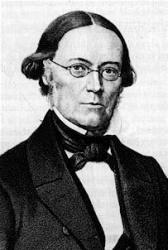? - 1530 Person Name: Georg Grüenwald Author of "Kom hid til mig, enhver især" Grüenwald, Georg, was an Anabaptist shoemaker, who suffered martyrdom for his principles, being in 1530 burnt at the stake at Kopffstain, or Kufstein, on the Inn below Innsbruck. To him is ascribed, in a manuscript Anabaptist Chronicle now in the Town Library at Hamburg, the hymn:—
Kommt her zu mir, sagt Gottes Sohn. [Christ's Yoke.] Founded on St. Matt. xi. 28-30. Appeared as "Ain schöns newes Christlichs lyed," in 1530. Wackernagel, iii. pp. 128-133, gives this in 16 stanzas and three later forms. The form in V. Babst's Gesang-Buch, Leipzig, 1545, is that in common use as in the Unverfälschter Liedersegen 1851, No. 421. It has been generally ascribed to Hans Witzstadt of Wertheim, but Wackernagel in a long note decides in favour of Grüenwald.
The translations are (1) "Cum heir, sayis Goddis Sone to me," in the Gude and Godly Ballates, ed. 1568, folio 16 (1868, p. 25). (2) "Come hither! saith our blessed Lord," by J. C. Jacobi, 1725, p. 35 (1732, p. 121), repeated as No. 151 in pt. i. of the Moravian Hymn Book, 1754. (3) "Come hither, says the Son of God," by Dr. H. Mills, 1856, p. 47. (4) "Come hither, says our blessed Lord," by Dr. G. Walker, 1860, p. 80. [Rev. James Mearns, M.A.]
-- John Julian, Dictionary of Hymnology
Georg Grünwald
